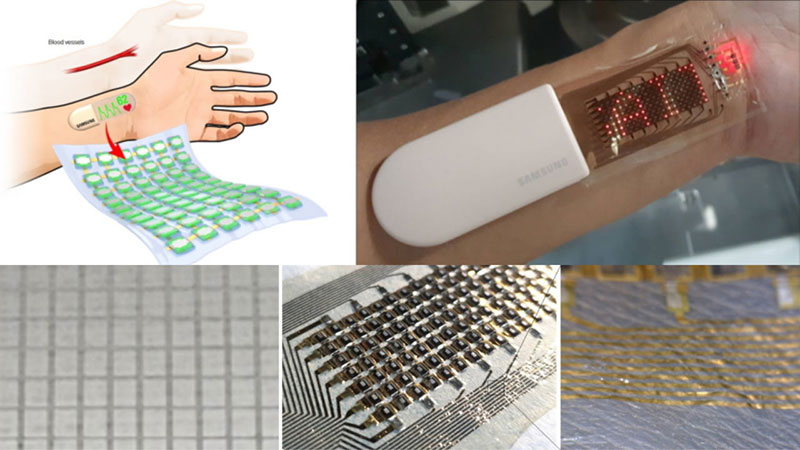Samsung has revealed a stretchable OLED display that acts as a heart rate sensor. The wearable device which can be mounted on the wrist, combines Photoplethysmography (PPG) heart rate sensors and an OLED screen to offer real-time heartbeat monitoring.
Read more Google and Samsung are merging Their Operating Systems
On June 4, researchers at the Samsung Advanced Institute of Technology (SAIT), Samsung’s R&D hub dedicated to cutting-edge future technologies, published research in the world-renowned journal Science Advances about a technology that overcomes the limitations of stretchable devices.
Through this study, stable performance in a stretchable device with high elongation was achieved. This research was also the first in the industry to prove the commercialization potential of stretchable devices, given that the technology is capable of being integrated with existing semiconductor processes, reports Samsung.
OLED ‘Skin’ Display That Can Be Stretched by Up to 30%
One of the biggest achievements of this research was that the team was able to modify the composition and structure of ‘elastomer’, a polymer compound with excellent elasticity and resilience, and use existing semiconductor manufacturing processes to apply it to the substrates of stretchable OLED displays and optical blood flow sensors for the first time in the industry. The team were then able to confirm that the sensor and display continued to operate normally and did not exhibit any performance degradation with elongation of up to 30%.
To put their research to the test, the SAIT researchers attached stretchable PPG heart rate sensors and OLED display systems to the inner wrist near the radial artery. Doing this allowed them to confirm that wrist movement did not cause any property deterioration, with the solution remaining reliable with skin elongation of up to 30%. This test also confirmed that the sensor and OLED display continued to work stably even after being stretched 1,000 times. What’s more, when measuring signals from a moving wrist, the sensor was found to pick up a heartbeat signal that was 2.4 times stronger than would be picked up by a fixed silicon sensor.

“The strength of this technology is that it allows you to measure your biometric data for a longer period without having to remove the solution when you sleep or exercise, since the patch feels like part of your skin. You can also check your biometric data right away on the screen without having to transfer it to an external device,” explained principal researcher Youngjun Yun, corresponding author of the paper. “The technology can also be expanded to use in wearable healthcare products for adults, children and infants, as well as patients with certain diseases.”
Overcoming Technical Challenges With Stretchable Materials and Structure
Implementing stretchable display technology proves difficult because usually when a display is stretched or its shape is manipulated, the device either breaks or its performance deteriorates. In order to overcome this problem, the SAIT researchers replaced the plastic material used in existing stretchable displays with elastomer. The system developed by the SAIT team is the first in the sector to implement a display and sensor using photolithography processes that enable micro-patterning and large-area processing.
Commercialization and Expanded Applications
The stretchable sensor was made in a way that makes continuous heartbeat measurements possible with a high degree of sensitivity compared to existing fixed wearable sensors.
Read more Samsung to Include Blood Pressure Monitor on its Galaxy Watch Active2
“Our research is still in the early stages, but our goal is to realize and commercialize stretchable devices by increasing system resolution, stretchability, and measurement accuracy to a level that makes mass production possible,” said principal researcher Jong Won Chung, co-first author of the paper. “In addition to the heartbeat sensor that was applied in this test case, we plan to incorporate stretchable sensors and high-resolution freeform displays to enable users to monitor things like peripheral oxygen saturation, electromyogram readings and blood pressure.”












